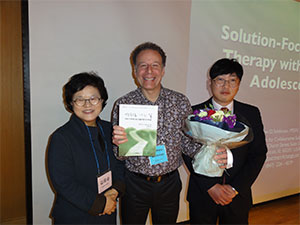
PATHWAYS TO SOLUTIONS WITH SELF-HARMING AND SUICIDAL ADOLESCENTS:
A COLLABORATIVE STRENGTHS-BASED BRIEF THERAPY APPROACH
Adolescent self-harming and suicidal behaviors are two of the most challenging presenting problems school professionals, healthcare providers, and therapists will face today in their clinical practices and professional settings. Therapists assigned these adolescents are often intimidated by their cutting, scratching, biting, and burning behaviors, frequent crises, and the army of helping professionals often already involved with these adolescents and their families. Most of these youth have experienced multiple treatment failures, feel lonely, emotionally disconnected from family members and sometimes their peers, and come from families where there may be difficulties with marital or post-divorce conflicts, invalidating family interactions, gender power imbalance issues, or family secrets. Individually, many of these youth have problems with mood management, struggling to cope with powerful self-defeating thoughts, and experience difficulties with self-soothing. Many of these adolescents regularly switch symptoms from self-harming, to substance abuse, bulimia, and sexually acting out behaviors. Since these youth and their families situations tend to be quite complex, they require a flexible, ecologically-based family therapy approach that targets interventions at the adolescent, family, peer group, school, and other larger systems levels.
The workshop format will combine information-rich didactic presentation, extensive use of videotape examples, and skill-building exercises. Participants will leave the workshop with many user-friendly, practical therapeutic tools and strategies they could put to immediate use with their most challenging self-harming and suicidal adolescent clients and their families.
Workshop Objectives:
- Differentiate self-harming behavior from true suicidal behavior
- Use therapeutic questions designed to elicit client expertise, well-formed treatment goals, untold family stories, and co-create compelling future realities
- Discuss how to use mindfulness meditation, visualization experiments, and other distress management tools that strengthen the adolescent’s self-soothing and cognitive skills
- Discuss several effective family connection-building rituals, therapeutic experiments, and art therapy techniques
- Discuss practical guidelines for parents on how they can prevent and constructively manage inevitable self-harming slips.
- The suicide watch: A family-social network strategy to prevent psychiatric hospitalizations
- Establish successful collaborative relationships with involved helping allies from larger systems

